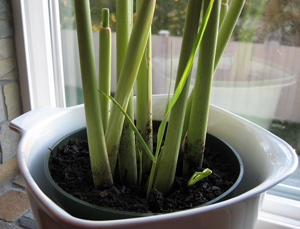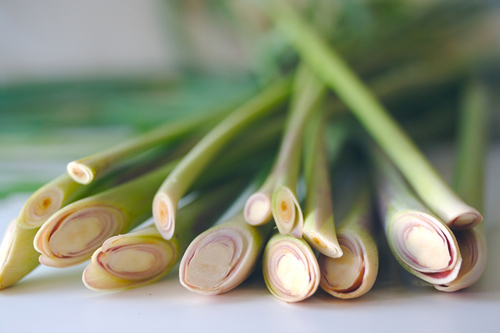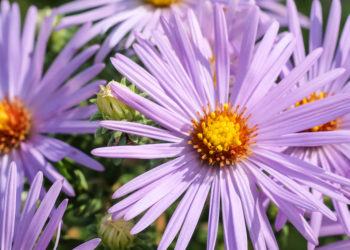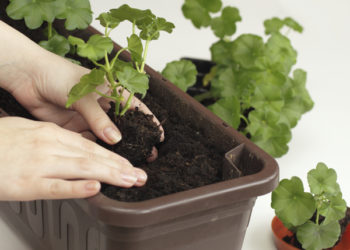If you’ve ever wondered exactly how to grow lemongrass, you’re in luck! We’ve got the easy to follow steps you need to make it a part of your garden this year.
Delicious and nutritious, graceful, lovely lemongrass (Cymbopogon citratus) makes a yummy addition to tea, soups, and stir-fries. This botanical wonder is also an excellent source of vitamins and minerals. And beyond the kitchen, you can use it as a natural decorative screen, as a mosquito repellant, or just enjoy its refreshing, calming, citrusy fragrance.
So if you’re tired of unsuccessful searches for it in your local supermarket, it’s definitely time to try growing it yourself– indoors or out. Here’s everything you need to know on how to grow lemongrass:
Lemongrass: Annual or Perennial?
As a tropical perennial, lemongrass will return its benefits, year after year. If you live in a very warm climate (Zones 10-12,) in which the temperature never drops below 40 degrees F, your lemongrass can remain happily outdoors year-round.
For the rest of us, you can plant lemongrass each spring from seeds, cuttings, or starter plants. You can also opt to grow it in large, portable pots. These can be moved inside when the temperature drops to overwinter indoors. Because if you tend it properly, it can live indoors throughout the year. But it will really thrive if you allow it to breathe fresh, outside air once it gets warm enough.
How to Grow Lemongrass: Getting Started
 First, you need some baby plants. You can either propagate them from seeds or cuttings, or get your hands on some healthy lemongrass starter plants.
First, you need some baby plants. You can either propagate them from seeds or cuttings, or get your hands on some healthy lemongrass starter plants.
If planting seeds, sow them about ¼ inch deep and 1 inch apart in your soil. Keep them warm and evenly moist, but not heavily wet. Because they take about one to two weeks to germinate, it’s recommended you begin them indoors and transplant into their permanent home once they’ve reached about 6 inches tall. If they’re destined for outdoor living, move them out when the outside temperature stays above 40 degrees F.
If you want to try your hand at growing them from cuttings, place lemongrass stalks, bulb end down, into about 2 inches of water and watch for roots to grow. Be sure to change the water every couple days to prevent stagnation and possible rot. Once the roots have grown about one to two inches (in about two to three weeks,) the plant is ready to transfer to your warm garden or large pot. Keep in mind, the cell structure of water roots is different from that of soil roots. So it’s imperative to keep the soil generously moist in the early days of transplanting. You can even cover the plant with a plastic bag to seal in the humidity. Another option is to add soil to the water daily to allow the roots to transition in cell structure.
But whether you’re growing from seeds or cuttings, it’s best to hold off on fertilizer until the plants are actively growing in their permanent home.
Planting Lemongrass: For the Outdoorsy Types
Once you’ve propagated or purchased your starter plants, transplant them to a sunny section of your garden. Set them about 24 inches apart into fertile, well-drained soil. Plant singles into prepared 5-gallon pots. If planted in a desert environment, some filtered afternoon shade is beneficial. Lemongrass does not tolerate heavy, wet soil, but must stay evenly moist. Never allow the soil to completely dry out. For desert-dwellers, they appreciate a heavy misting in the mornings.
Your lemongrass will benefit if regularly fed a nitrogen-based fertilizer. Alternatively, plants can be grown in beds of composted soil into which you routinely add organic material. As always, mulching will retard weed growth while maintaining moisture. Keep in mind that potted plants will always need supplemental feeding.
In ideal conditions, lemongrass will reach 3 to 6 feet tall (in the shorter range for potted plants). Which means they serve double-duty as a decorative ornamental grass. Plants form a rhizome, or bulb, but do not aggressively spread, so normal harvesting and occasional cutting back of the longest top growth will satisfy the more formal gardener.
Planting Lemongrass: For Indoor Enthusiasts

The success of growing lemongrass indoors depends upon replicating healthy outdoor conditions as much as possible. Among other things, that means planting them in fertile, well-drained potting soil and regularly feeding them with a nitrogen-rich fertilizer or adding earthworm castings. This is especially important since potted plants quickly deplete their nutrients. They depend on you for continued sustenance.
To help your lemongrass plants reach their greatest indoor growth potential, plant them in 5 gallon pots, approximately 12 inches in diameter. You can grow more petite plants by placing them in smaller pots and harvesting more often by carefully removing the stalks, bulb and all, along the outside of the plant.
Ensure your potted plants bask in the sun as much as possible by placing them in unobstructed sunlight. Preferably near a south/south-western facing window. And, just like their outdoor cousins, your indoor lemongrass plants prefer moist soil. The smaller the pot, the quicker they can dry out. If you have to be away for awhile and don’t have a plant-sitter, a product with water saving crystals can help maintain moisture longer.
Harvest Time!

Once your plants are about a foot tall, you can begin to reap the culinary benefits of their lovely foliage. Snip with sharp scissors or garden shears (ahhh, inhale that lemony fragrance!) and use the leaves for flavoring teas and soups. If you cut more than you currently need, dry the extra leaves and store for later use (check online for various drying methods.) The outer leaves are sometimes tough. But even those can be used by bruising them, adding them to your recipe for flavor, then scooping them out before serving, much like you would bay leaves.
When harvesting the stalk for recipes, use a sharp blade and cut as close to the soil as possible. It’s the soft, inner part of the stalk closest to the base that is most often utilized. Stalks can be kept in the fridge for several days by keeping them in a plastic bag with a damp paper towel. You can also chop pieces of the stalks and freeze them for later use.
A simple google search will unearth a wealth of recipes for all parts of this aromatic, edible plant. Lemongrass is most often used in Asian dishes. But there are other delightful, surprising ones such as ice cream and smoothies.

Oh, and one more thing:
Cats LOVE nibbling on lemongrass and enjoy its catnip-like qualities. This is fine for the cat, in moderation, but not so much for the plant.
So if your plants share their home with feline company, consider reserving a plant for them to snack on. Keeping the others out of harm’s way. (Um, good luck with that! LOL. We have heard that spraying the plants with diluted lemon juice sometimes works. As do some pet repellent products.)
Excited to add lemongrass to your garden? We have skillfully started, organically grown West Indian lemongrass plants to get you growing!





40 Comments
J.P.I.
March 13, 2013 at 3:42 pmHello, I’m looking for information on how to grow lemongrass here in South Carolina. I can also grow it indoors, if it will grow there. I’ve got the space. But where do I locate the lemongrass seeds? Thanks, J.P.I.
Karen
March 15, 2013 at 3:28 pmJ.P., you can grow lemongrass outdoors and according to your Zip Code you are in Hardiness Zone 8a, which means it should most likely remain as a perennial plant, although if you have the threat of a severe winter you might want to protect it with some extra mulch around the root system, or dig it up and bring inside. If you want to grow it indoors it would need a sunny and warm location away from drafts and heating/air conditioning vents. Soil and water conditions would be the same as outside.
Lemongrass prefers full sun and some room. A mature plant can reach 6 feet in height and be up to 40 inches wide. It wants a well-drained, loamy soil, so make sure you don’t have heavy clay, or that water does not stand in the area you’re planting. If you can check the pH it should range between 5.1 and 8.5. It doesn’t like to dry out, either, so it will need to receive even moisture throughout the summer growing season. You could also grow it in a pot, which would keep it at a slightly smaller size.
We do not carry the seeds but we do sell the East Indian Lemongrass (cymbopogon flexuosus) variety plant on our website. They are beautiful, healthy starts that will get you harvesting sooner.
Happy Gardening,
Karen
Justina
January 23, 2014 at 4:13 pmI have a lemongrass plant that is full grown and has seed. I am trying to figure out what I can do with the seeds, how to dry them and prepare for seed or tea. Do you have any recommendations or videos?
Thanks
Karen
January 28, 2014 at 4:27 pmSaving the seed from lemongrass would be like saving any other seed. Make sure it has matured and then save it in a cool, dry location. While it can be sown from seed, it is usually easier and more successfully propagated from cuttings or culms that are sold in a grocery store. Seed germination is a bit erratic and it require sowing in early spring in small pots and in a 55-65 degree temperature range.
You would use the long leaves to make tea, sorbets or infusions for bathing. The peeled, lower stem is the portion you use for cooking.
Here is one video: http://www.youtube.com/watch?v=0YsQXmN5voc
Happy Gardening!
Karen
joanne
March 27, 2014 at 8:05 ami live in zone 6 and would love to have lemon grass in pots on my patio..would i be able to cut them down in fall and leave them outside like i do other ornamental grasses. will they return the next year on their own?
jstutzman
March 28, 2014 at 9:04 amHello Joanne. Lemon Grass would not survive the winter in zone 6. However you could bring it inside for the winter and replant it each spring. You would have to live in zone 8 for it to come back in the spring. Happy gardening!
YingDonaldson
April 19, 2014 at 12:33 pmWell, I planted Lemongrass last year and they were died this Winter. I am in South Carolina, Zone 7. If I moved them inside in Winter, what should I do with them? How to storage it? Please advise? Thank you!
Karen
April 25, 2014 at 7:53 amLemongrass is only hardy to Zone 9, so if you are in a Zone 7 area of South Carolina you will need to bring the plant indoors in the winter. You could try growing it in a container so you can easily move it indoors as temps drop, or dig and pot up before the first frost. Lemongrass needs full sun, up to 6 hours of sun per day, and it should be fertilized every month with a general purpose, higher nitrogen fertilizer. If you grow it in a pot, use a well-drained potting mix. If you plant outdoors in the summer and it becomes too large, try taking cuttings late summer to bring inside for next year’s outdoor plantings.
Happy Gardening,
Karen
Will
June 1, 2014 at 8:49 amHello Karen! I am wondering how long it would take lemongrass seeds to grown as we are now in June. We live in New York and have a rooftop with plenty of sunshine. If I plant seeds, how many should I plant and how long would it take to grow? If I wanted to buy a small 4” plant that is already on its way, can you point me in the right direction to a product? Thank you!!
Karen
June 5, 2014 at 9:51 amWill, starting the seeds indoors, use a 2-3 inch layer of seed soil, or equal parts coarse sand, peat and compost. Plant seeds approximately 1 inch apart and 1/4-inch deep. Cover the seeds with thin layer of compost or vermiculite and gently dampen the soil. Cover the seed tray with provided cover or clear plastic wrap and place in warm location, 70 to 75 degrees until sproutednot in the sun. Once sprouted, remove the plastic wrap and place in full sun until the sprouts become stable seedlings, usually in two to four weeks.
If you want to get a head start with growing the lemongrass, we have plants available for sale here, http://www.gardenharvestsupply.com/productcart/pc/lemon-grass-herb-plant-p804.htm. Enjoy your fragrant new herb!
Overhaul Your Medicine Cabniet: Medicinal Tea
June 11, 2014 at 2:33 pm[…] is another really easy to grow herb. You can even grow it inside (find out more here). Lemongrass has many great properties it is antibacterial, anti-fungal, anti-inflammatory, and […]
Moonblue54
June 26, 2014 at 11:05 amI live in coastal Alabama. I’ve been growing lemongrass for years. I bought 4 or 5 stalks at an Asian market for $1 and they’ve been the best plant investment ever! My original plant had grown huge. I thought the unusual harsh cold snap we had last year reduced had killed it. I was getting ready to throw it out, but the pot was so large and heavy I never got around to it. Glad I didn’t! It started regrowing and now the leaves are over 3 feet tall and it’s a beauty!
Sulj
July 30, 2014 at 10:18 amHi,
I stay in zone 7b and I have a patio where I would like to grow lemongrass plant. Can I cut them short and leave them out over winter? OR would it die? Can I just grow a small pot and not repot it (so if it dies in winter, I can get a new one in spring?)
Karen
July 31, 2014 at 7:22 amLemongrass is only hardy to Zone 9, so you would not be able to leave it outside over the winter. It will freeze and die. If you plant it in a pot, you can bring it indoors and place it in front of a sunny, draft-free window and overwinter it, or let it die and buy a new plant in the spring.
Happy growing~
Karen
Quid
October 2, 2014 at 11:57 amHi, I live in zone 8b. Is there any way that I can get my lemon grass to live outside during the winter? I hear that lemon grass is fine in zone 8 but I also hear that it only grows in zone 9? Its very confusing.
jstutzman
October 2, 2014 at 3:40 pmHello Quid. Lemongrass is hardy down to zone 8, so with some good mulching, your plant should be just fine.
Kati Olson
April 1, 2015 at 9:45 pmwill lemongrass grow well in West Virginia, eastern panhandle?
jstutzman
April 2, 2015 at 9:51 amYes Lemongrass will grow in your area. Without knowing your zip code, we can’t determine if it would grow as an annual or as a perennial. GHS
Lindsey
June 8, 2015 at 7:11 pmHi, I live in Oklahoma. I’m using the lemon grass to help with Mosquitos. How do I help it bush out more to make it prettier and how do I harvest the stalks to make lemon grass?
jstutzman
June 9, 2015 at 3:47 pmLindsey, Your plant will fill out better as it gets larger. For harvesting tips, read this article. Good luck with your lemon grass plant! GHS
Barb
January 1, 2016 at 8:01 pmI live in central Florida and have two lemongrass plants that have gotten HUGE! Probably 15+ feet tall and happy. One I trimmed down to about 5′ and it is back and taller than ever. From what I’ve read, they typically only grow to 6′. Suggestions? I don’t want the plants taller than my house! How often can I trim back? Thanks so much!
Richard Clark
March 15, 2016 at 1:06 pmI have a spot that get morning to noon sun on the East side of my house, will that be a good place to plant my lemon grass or do I need to find a spot that gets more sun? My zip is 77437.
jstutzman
March 18, 2016 at 1:02 pmRichard, that would be a fine spot for your Lemon Grass plant. GHS
RxL
March 30, 2016 at 5:10 pmHi! I am looking at planting Lemongrass in containers, more for ornamental purposes, and placing them on my front lawn patio about 10′ away from the house. My house faces north and my zip is 92563. Any suggestions and tips? When and how do I prune so that it stays somewhat neat? Thanks!
jstutzman
April 28, 2016 at 2:22 pmHello RxL. Prunning can be done totally as you see fit. You will need to make sure the lemongrass plant recieves full sun in that location. Otherwise you should be ready to plant. Good luck! GHS
Karen
April 19, 2016 at 9:23 amCan I plant lemongrass outside in zone 5 in late April?
jstutzman
April 28, 2016 at 2:05 pmKaren, you should wait till your last spring frost date. This Average Last Frost Date map will give you a good idea. Good luck, GHS
Justgh
April 26, 2016 at 9:57 pmI live in Palm Beach County, Florida (33405), and I cannot get my lemongrass plants to flourish. They are in containers and get direct eastern sunlight from around 8am until around 1pm. I water them when the soil becomes dry. Still, however, They have not grown and tend to develop dry, dead leaves.
I would greatly appreciate any suggestions!
Many thanks,
GHF
jstutzman
April 28, 2016 at 2:00 pmGHF, since lemongrass wants full sun, it might be that the morning sun is not bright enough for them. And, they probably need some fertilizer. You might try moving them to a place where they can get six to eight hours of midday sun, generally a southern exposure. They should grow very well outside. As long as they are in a well-drained soil and draining pot, it's OK to water them more frequently. Don't let them get fully dry between waterings. Since you are in a warmer climate, it wouldn't hurt to give them some water daily during the summer months. During the summer you need to feed lemongrass weekly with a water-soluble, high-nitrogen fertilizer. The rest of the year, a monthly feeding will suffice. Also make sure they are in a large enough pot, something close to a 16-inch diameter per plant. In the winter make sure they’re in a south-facing window to receive as much light as possible. Also watch for spider mites, one of lemongrass’s only pests. If you spot them, you will notice pale specks on the leaves. Give the plant a nice bath with a dilute dish soap (not the antibacterial kind) like basic Dawn, and a good blast with the hose.
I hope this helps and that you get a great crop of lemongrass.
Karen
Master Gardener
Garden Harvest Supply
Cory olson
August 14, 2016 at 7:10 pmI live in North Dakota, depending on the year winters can be harsh. Can lemongrass make it? I would hate to have to dig it up and bring it in every year
jstutzman
September 1, 2016 at 5:42 pmCory, lemongrass will not survive your winters in North Dakota. You will either have to dig them up or start with fresh plants in the spring. Happy gardening!
Ceejay
August 16, 2016 at 5:57 pmHi!
I live in New Orleans (zone 9?) and have a lemongrass plant growing in my backyard. It was planted last July and is now 5-6ft tall. I do absolutely nothing to it. It gets sun from the east and south, and is shaded from the western sun exposure. I ripped out my lawn a few years ago, and the plants I planted are suffering in the intense heat we have this summer. Since the lemongrass is doing so well in the backyard I would like to dig up my current plants and grow lemon grass. If I do that, the lemongrass would be in FULL burning hot sun all day, with no shade at all. I’ve read that they love full sun, but would that be too much? Physical and financial limitations would make this an ideal plant for that area. I LOVE it and would plant it everywhere if I could! I also read that it repels snakes, and i believe it because there are snakes in the woods nearby but I have never seen one in the area of my yard where my lemongrass is growing. Thanks in advance!!
jstutzman
September 1, 2016 at 5:41 pmCeejay, congrats on your growing lemongrass plants! You have read correctly, lemongrass loves the heat. You just don’t want them to dry out, so make sure they have a source of moisture. Here is more reading info on growing these plants; growing lemongrass in the south.
Ida
August 29, 2016 at 6:01 amI have two lemongrass plants and would like to plant them in the ground. They are growing fine on the patio and winter is coming. We live in Minnesota south of the Twin Cities and 55122 zip. can I plant them and maybe trim them down some?
jstutzman
September 1, 2016 at 5:37 pmIda, lemongrass will not survive outside in your area. You will have to bring them inside or start with new plants in the spring.
Susan
November 16, 2016 at 4:59 pmI bought a 4″ pot of a clump of lemongrass. Seems like there are about 50 tiny 8″ seedlings (?) in this clump. Is this correct? Should I separate them? Leave them? I’m growing them indoors for now (zone 5). Thanks.
jstutzman
November 17, 2016 at 3:18 pmSusan, that sounds about right, and no you do not need to separate the plant. However, you certainly are able to do so without harming it. Good luck, Joe
Joni
April 18, 2017 at 4:58 pmI live in Yuma,Arizona. Could I plant Lemon Grass on South side of my house? How would it do during the hot summer?
Carol
April 19, 2017 at 12:47 pmMy lemongrass plants were inside for the winter in Zone 6B. They are dried and brown even though I watered them. Will they come back or should I throw them in the trash?
jstutzman
August 10, 2017 at 8:00 amCarol, they should be thrown away.